Inbound marketing is a way for companies to connect with and influence customers in a way that builds trust and fosters long-term relationships. It helps marketers create a customer experience that attracts prospects and increases visibility in a way that people don't feel ‘sold’ to.
A core element of inbound marketing is content. You may have heard the term ‘content is king’, but in the case of inbound, it really is.
What this means is that quality trumps quantity and that’s what marketers should prioritize in their inbound marketing strategy. But there’s a lot more to inbound marketing than simply creating great content.
Industries that are highly regulated, costly, or require information and guidance to help people through a process can benefit from inbound marketing. These industries include healthcare, financial services, manufacturing, recruitment, and education.
In this blog, we look at what inbound marketing is, how it compares to outbound marketing, how to create an inbound marketing strategy, and examine great examples to give you an idea of what works.
Inbound marketing definition
Inbound marketing is a strategic approach that focuses on creating valuable content and experiences tailored to the needs of your audience to build long-term relationships.
The key to inbound marketing is that it provides solutions to the needs of your customers. By doing that you can build lasting relationships and cultivate brand advocates.
Inbound marketing vs outbound marketing
Marketers across industries are likely to use outbound and inbound marketing strategies to engage and convert leads. But what are the differences between them?
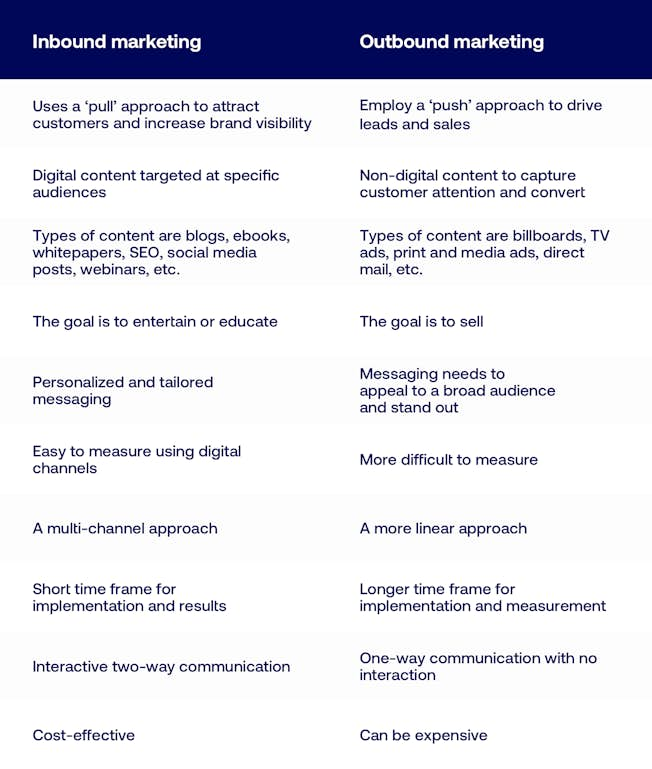
When should you use inbound marketing?
The advantage of inbound marketing is that it attracts people that are actively looking for the service or product you provide.
For example, if a user types ‘lightweight touch screen laptop’ and you sell that product, then inbound marketing will help you to be visible to that person.
There are a few reasons you might choose an inbound marketing strategy:
- You know your target audience - If you know who to target, inbound marketing can be a great way to draw them in. SEO is a great example of this, if you research relevant keywords you can use them on your site and blogs to attract the right people. This works if you are working in a niche industry or area such as manufacturing or mining. Read our SEO Keywords Research toolkit to see how to do it.
- You want to engage an audience - If you’re looking to have a conversation or drive engagement, inbound marketing techniques are very effective. Polls or surveys can be great in this scenario and not only drive engagement but provide further insight into your audience. This may be helpful for anyone in, say, the healthcare industry looking to find out more about opinions on a product or for brand perception.
- You want quality leads - With inbound, it’s quality over quantity when it comes to leads. That’s because you are using a targeted campaign to known personas. For example, if you work in the education sector and want to target people looking to gain a credential to start a career in digital marketing, create an ebook on the subject ‘Kickstarting your Digital Marketing Career’ which will provide information but also capture data for retargeting.
- You need to measure ROI - With inbound marketing you can track and measure performance on an ongoing basis and tweak content if required. As ROI becomes more important to senior executives you need to measure campaigns to allocate budget and resources.
- You have a long sales cycle - For many B2B businesses, a long sales cycle is the norm. Prospects, in this case, need information and guidance and videos can be useful. Consider a video series with an expert or staff member with skills in a certain area. You can measure engagement to determine efficacy.
- Budget is low or limited - An inbound marketing campaign can be cost-effective. Blogs are also a great way to attract an audience if you know their needs and provide a solution. Remember to include keywords to get your audience there in the first place! Check out these tools and templates for creating successful blogs.
When should you use outbound marketing?
The great thing about outbound marketing is that it guarantees your brand will be seen and is a great way to attract an audience. Many of the channels are also tried and tested and trusted by an audience.
There are a few reasons to use outbound marketing:
- You need to drive brand awareness - As we’ve said, outbound marketing helps to drive brand awareness whether that’s through a paid Facebook ad to a targeted audience or a TV advert. It guarantees eyes on your brand and can help grow your audience.
- You are launching a new product or service - If you have a new product or service coming, you can send advance emails to your mailing list with a personalized subject line or offer.
- You need results fast - If you need the campaign to get results quickly, paid search ads targeted at a specific audience can be highly successful. Make sure your landing page is related to the content in your ad and has engaging copy so it can help drive conversions.
- You want to connect with a new company - Sometimes the old methods work - cold calling is a great way to make contact with a target prospect or company. It can take time but a conversation can be valuable for building connections and reaching out to solve a problem or provide a solution.
- Your target audience is older - While TikTok may be the platform of choice for many young people, the older generation turns to radio, TV, and newspapers for their news and entertainment. According to Nielsen, people aged 50 and older spend close to six hours (ages 50-64) and more than seven hours (ages 65+) a day watching TV.
- You want to be visible to the right people - Every brand needs to promote itself to stand out from the competition and stay front of mind. Trade shows and events offer an opportunity to have a booth or take part in a talk that helps a brand connect with the right people. For example, a food and drink expo would offer an alcoholic brand a platform to offer taste tests and raise brand awareness.
Fundamentals of inbound marketing
- Clients or customers - Your contacts are a crucial part of any inbound marketing strategy. These include those on your email or newsletter list along with partners or clients. Keep your contact list up to date and include as many details as possible to enable segmentation and personalization.
- Buyer Personas - To guide your marketing activities you should have buyer personas based on data and insights that state who your audience is, what they like and how to target them. Use our buyer persona template if you need help developing these.
- Buyer's Journey - This follows the journey of the customer from the awareness stage through to the consideration stage and finally to the decision-making stage. You should be aware of all stages and touchpoints through the buyer’s journey to help craft the right message and content.
- Content Creation - Now that you know your audience and journey you can make decisions about the type of content to create. For example, at the awareness stage, a blog or informative video will grab attention while someone at the decision marketing stage wants more information such as a whitepaper. Have a look at our webinar on ‘How to Create Great Content that’s Guaranteed to Engage Your Audience’ for some tips and guidance.
- Business Goals - It’s crucial to understand and note your goals before you launch any campaign. That way you will meet your business objectives and have a baseline to work from to measure performance.
Inbound marketing strategy
Now that you understand the fundamentals and reasons to use an inbound marketing approach let’s look at how to create an inbound methodology to build lasting relationships with your customers or clients.
An inbound methodology can be applied in three ways:
- Attract
- Engage
- Delight
Each way uses different content to engage and convert.
Inbound marketing funnel
The definition of an inbound marketing funnel uses a few key terms ToFu, MoFu and BoFu. These translate as top of the funnel, middle of the funnel and bottom of the funnel to coin the customer journey at different stages and your relationship with them.
The illustration below shows the different tools and content types used to attract, engage and delight people at different stages.
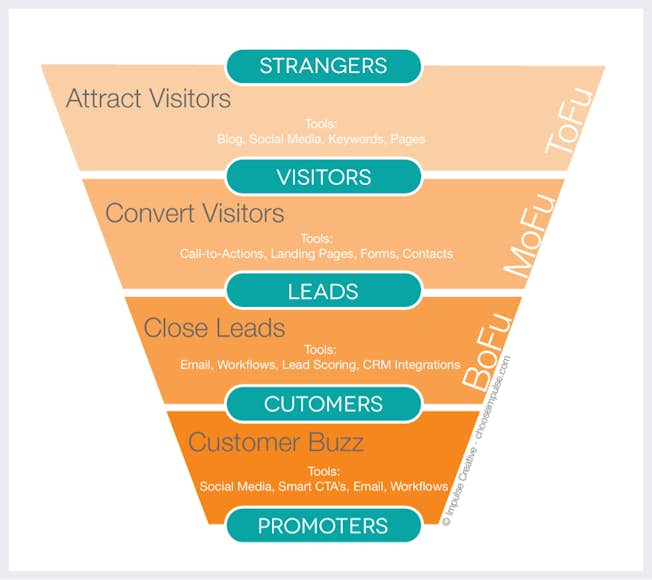
HubSpot created a Flywheel model that shows the momentum you can get by prioritizing and delivering exceptional customer experience. You can spin and build momentum in your flywheel by using strategies that acquire and retain customers — forces for your flywheel.
Anything that slows your flywheel is friction. Often the biggest friction sources can come in the handoffs between teams, so alignment and communication are key to keeping your flywheel spinning.
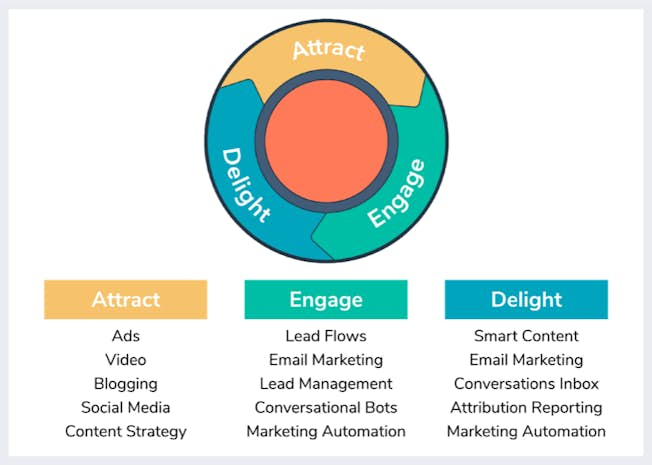
Using social media and email for inbound marketing
Two effective channels to use for your inbound strategy are social media and email. Let’s look at ways these two channels can help you to drive engagement and conversions with personalized and targeted content.
How to use social media for inbound marketing
Social media aligns with the inbound methodology and provides a channel that can promote content to your prospects and learn more about how to engage with them. Using social media you can:
- Promote your content - It can take time for organic content to get views and backlinks. Promoting your content on social media allows you to create targeted campaigns that speak to a niche audience who are more likely to convert.
- Build a community - Channels such as Twitter and TikTok offer a great way to build a community on social media through real-time posts and eye-catching videos. You can also tap into and create Facebook groups that are relevant to your product or service and Instagram is a great place
- Use influencer marketing - According to The State of Influencer Marketing 2022: Benchmark Report, the influencer marketing industry is set to grow to over $16 billion in 2022. Platforms such as Instagram and TikTok are the perfect tool for using influencers to promote products and content in a way that attracts and delights.
- Offer social customer service - Social media is used by many customers to make inquiries or complaints. You can use it to offer solutions to customers and build relationships. Here are some tips to deliver stellar social customer service on your channels.
- Track performance and optimize - Through paid campaigns and analytics you can quickly learn what ads are working and tweak those that are not performing. This can include image changes, the content format or the messaging used.
Develop or tweak your social media strategy to drive brand awareness and ROI if you don’t already have one in place.
How to use email for inbound marketing
Inbound email marketing is focused on using email to engage with people that have already shown an interest in your brand or product/service. This could be through a sign-up, download, or taking up of an offer such as a free trial.
According to Statista, the number of email users is set to rise to nearly 4.6 billion by 2025 with marketers reporting an increase in email. The ROI of email is also impressive at $36 for every $1 spent.
There are different types of email you can use to drive engagement with a lead. Let’s look at the four most popular.
1) Welcome or onboarding email
When a contact signs up for a newsletter or offer that requires onboarding, it’s important to send them a welcome or onboarding email. This will put your brand in front of them within minutes of them expressing interest and tell them what to expect.
This example below from SaaS company scheduling company, MindBody shows an email that welcomes a customer and tells them the options available to improve their approach to wellness. It also links to their Instagram account at the end.

2) Cart abandonment
When a user adds a product to a cart and then abandons it for some reason, it can be effective to follow up with an email that reminds them of their intention and prompts them to complete the transaction.
Online women’s clothing company Le Tote uses clean imagery alongside clever and simple copy to re-engage a prospect, including ‘it’s about to expire’ in the follow-on copy drives urgency and the CTA simply says ‘Start Renting Today’.

Check out our blog ‘Reduce Your Shopping Cart Abandonment Rates’ to get some tips and tricks in that area.
3) Discount or special offer
Discounts or exclusive offers can re-engage contacts that have not been active on your site or engaging with your brand. This example from the Google Store taps into the summer season and offers a range of deals on devices with a simple ‘Shop Now’ as the CTA.

4) Trends or ‘best of’
To promote yourself as an industry leader, an email that focuses on your sector and is relevant to your audience can drive click-through. This could be a link to a blog or a landing page for a downloadable asset that can not only engage but capture more details about a prospect.
This example from Fiverr focuses on trends for small businesses with a short description in the text and a CTA that drives people to the needs index. Think about what assets you could create or even repurpose to drive email engagement.
Think about creating an article on upcoming trends like ours - 'The Next Big Digital Marketing Trends in 2022' - to help drive traffic and set yourself up as an industry leader.

Inbound marketing tools & software
So what tools should you be using for digital marketing - inbound and outbound? There is a bounty of apps to help generate leads, remarket, nurture prospects and make more sales! In this section, we’ll break them down into categories so you can find the right one for your goal.
Email inbound marketing tools
MailChimp - MailChimp is a great tool for email marketing and can be used easily by beginners and experts alike. You can use it to develop and test email templates, manage lists, apply segmentation, and keep track of your email campaigns.
Klaviyo - Useful for personalizing emails and SMS, Klaviyo is designed to help you scale your email operations and drive segmentation based on user behavior and preferences.
Social media inbound marketing tools
Hootsuite - A complete social media management tool, Hootsuite can help you simplify your marketing, accelerate your sales, and streamline your customer service.
Buffer - Combining personalization and automation, Buffer makes it quick and easy to schedule bulk updates to the major social media networks. You can also import content from your favorite blogs, and re-share top-performing content.
Sendible - Designed for agency owners and marketers Sendible offers a share button to share content quickly and easily and provides a mobile app that gives access to powerful monitoring, engagement, analytics, and more.
Automation inbound marketing tools
Zapier - An automation powerhouse, Zapier connects to over 4,000 apps and integrates tons of applications to automate workflows.
HubSpot - Developed for inbound marketing, sales and customer service HubSpot offers a range of tools under one roof. It helps marketers create, optimize and promote content, build lead generation funnels, automate lead nurturing, and report on performance.
Content inbound marketing tools
Ahrefs - Ahrefs is a tool designed to optimize your content creation. With a focus on SEO, the platform offers a suite of search-focused tools, including keyword and backlink analysis along with content analysis features.
Feedly - This software helps you track relevant content across the internet using Leo, Feedly's AI engine. The platform flags important insights from everywhere, including news sites, blogs, Twitter, and newsletters.
Grammarly - A useful tool for any content marketer, Grammarly uses AI to identify and search for mistakes in copy and offers replacements. It reviews spelling, grammar, punctuation, clarity and engagement to help optimize your content for SERP.
What are examples of great inbound marketing?
Now you know the ins and outs of inbound marketing it’s time to look at some examples to get inspiration from brands and industry leaders to see how they use it in their campaigns.
1) Cisco Healthcare - Blog
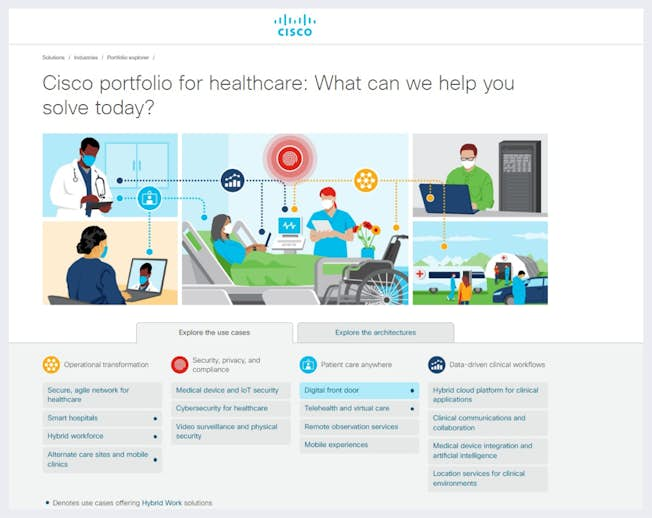
A great example of inbound marketing is Cisco’s Healthcare blog which covers a range of healthcare topics posted weekly written by experts in the field. The aim is to provide relevant and expert content that informs but includes links that click through to Cisco’s portfolio of healthcare.
2) Patagonia - Storytelling & Activism
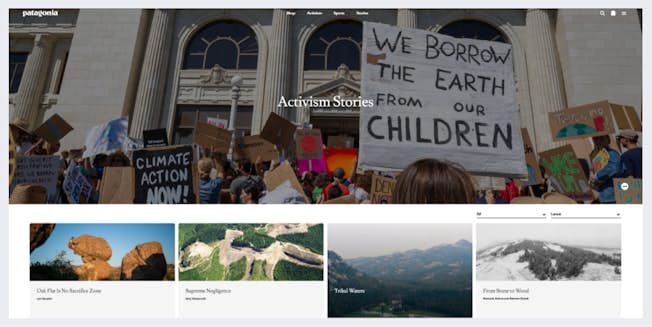
Patagonia is a brand with a voice. The brand is ultimately an outdoor clothing line but it has spent years speaking out about sustainability and environmental issues to attract and engage customers. In fact, it’s probably better known in the public arena for being outspoken on social issues through stories, films, and media rather than its clothing. But one serves the other as the brand has been around since 1973.
3) Weetabix - Social media
The breakfast staple Weetabix could be seen by many as boring but their recent Twitter campaign shook that perception up. Through a multi-channel campaign, Weetabix sparked debate and engagement by pairing its cereal with baked beans with the copy leading with ‘Why should bread have all the fun, when there's Weetabix?’

The post across Twitter drove engagement not only amongst Twitter users but also among other brands who responded (see Specsavers below). This created a buzz around Weetabix and drove brand engagement using an inbound approach.

4) Digital Marketing Institute - Webinars
Consumers today seek out information online and want to find solutions to their questions. Webinars are a great way to not only inform and educate but also drive data capture. At DMI we host regular webinars on a range of digital marketing topics to provide relevant and up-to-date information that can help enhance knowledge to drive careers. These webinars offer people around the world a way to ask questions in a live environment that can be replayed at any time providing a valuable asset. It’s a great way to attract an audience in a way that informs and delights.
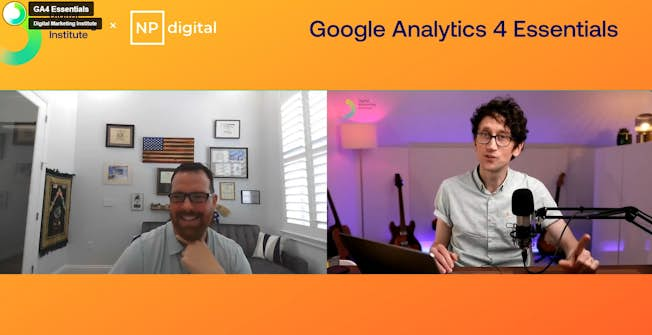
Become an Inbound Marketing Pro
Inbound marketing tactics are a way to engage with your audience in a way that builds trust and offers value. DMI’s Professional Diploma in Digital Marketing will introduce you to the fundamentals but also dive into key tactics such as content marketing, SEO, PPC, display and video ads, and strategy to help you drive traffic, leads and sales. What are you waiting for, enroll today!
Related
Upgrade to Power Membership to continue
your access to thousands of articles, toolkits, podcasts, lessons and much much more.
Become a Power Member- Login
- View Courses
- - - -
- Courses
- Resources
- - - -
- My Account
- Change Password
- Logout





